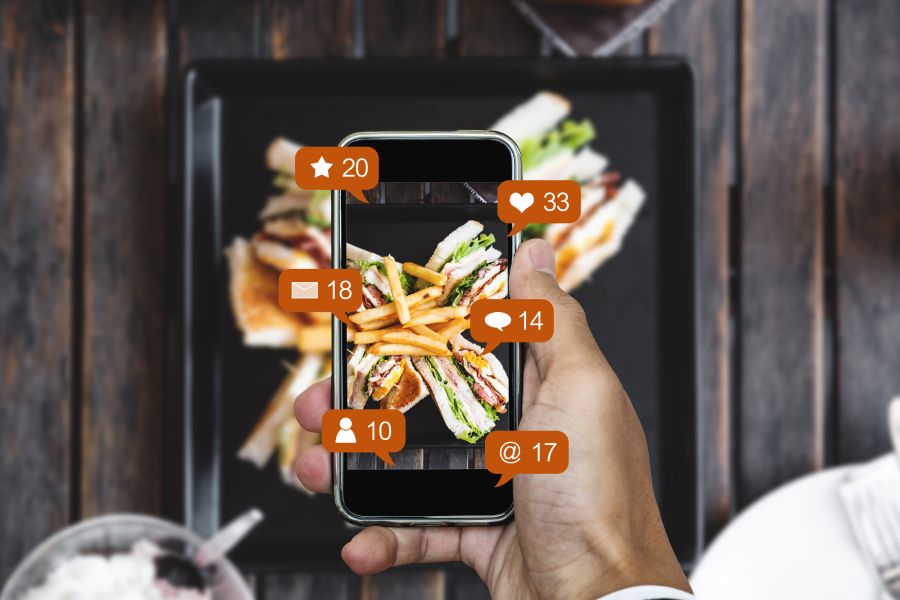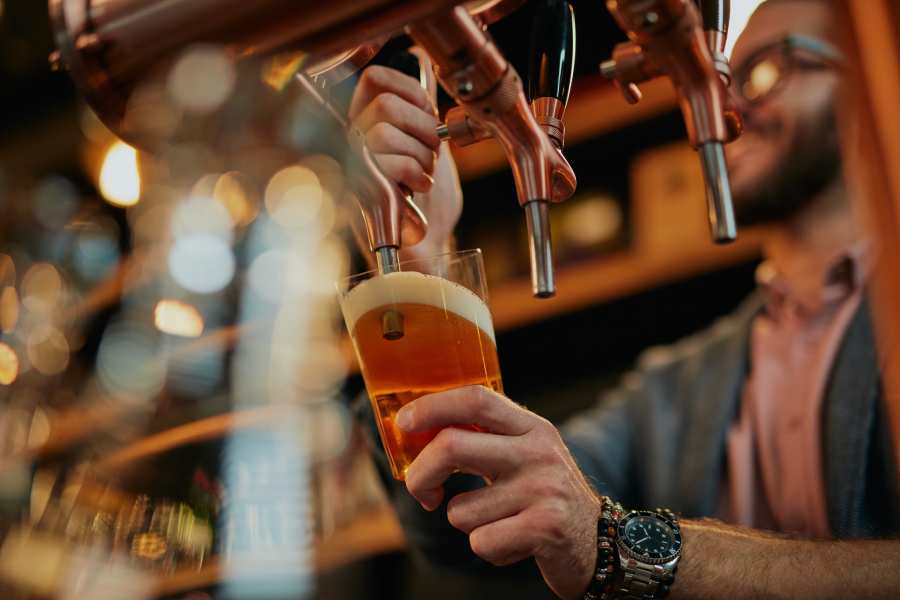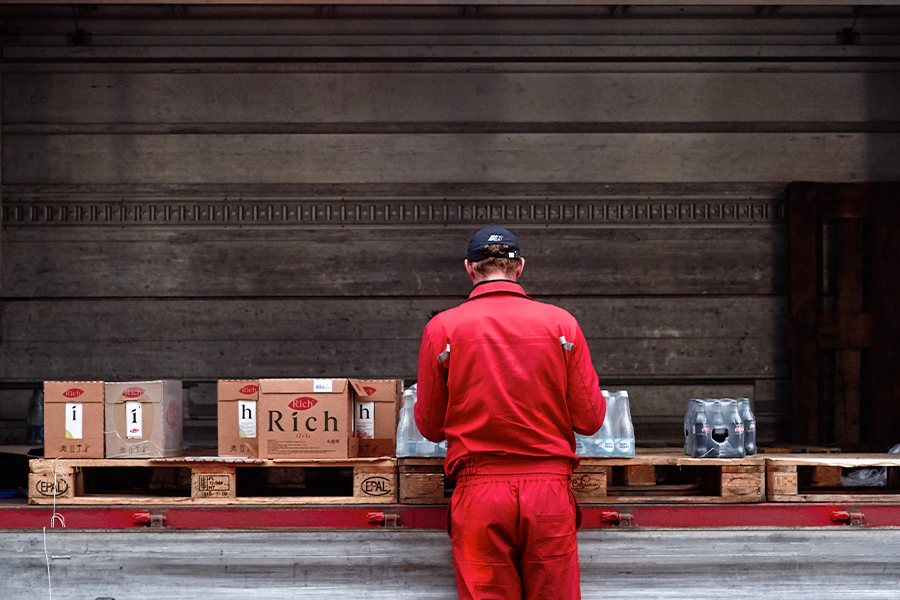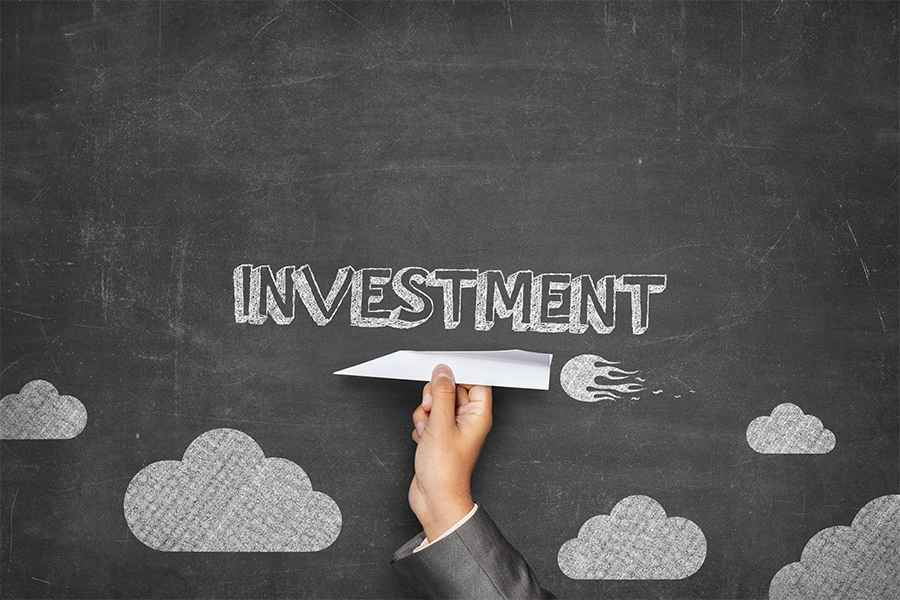
Restaurant influencer marketing may seem like an iffy proposition: Paying someone to eat your food and post about it on social media? And yet, it’s a growing industry with a significant effect. According to a survey by MGH, Inc., 53% of millennials (and 38% of TikTok users of all ages) have visited a restaurant or ordered food after seeing it on TikTok. The same study showed that those diners spend more per visit as well.
Of course, not all influencers are created equal—and like most marketing ventures, they don’t come free. We’ll cover restaurant influencer marketing, how to find and work with an influencer, and some best practices.
What Is a Restaurant Influencer?
A restaurant influencer is simply a person who uses their online platform to promote restaurants or dining experiences. You can find restaurant influencers on multiple social media platforms, though Instagram and TikTok tend to be the most popular and engaging for restaurant content.
Types of Restaurant Influencers
Restaurant influencers don’t have a specific education; they just have to be able to share their passion in a way that attracts and convinces others. However, they may specialize, and knowing the different kinds of restaurant influencers can help you when deciding which ones are best for your marketing needs.
- Food bloggers: These people share their love for the food itself. The best ones can describe a meal vividly and entice people to come for the food. They may also share dining tips, and people trust their palates. Food bloggers are a good choice for just about any kind of restaurant from food trucks to fine dining.
- Chefs: People trust chef influencers to understand what makes a good meal. Keep in mind that “chefs” can include amateurs or at-home cooks who have established their credibility. Like food bloggers, they are a good general choice, although finding a chef influencer in your cuisine adds credibility (but note that the competition might be tougher).
- Family (Mom and Dad): If you have a family-friendly restaurant, mom and dad influencers speak to your audience. They often highlight kid-friendly menu options, entertainment, and other family-fun features.
- Vegan or health food: These influencers specialize in a specific type of food: vegan, gluten-free, and organic. They’re a good choice if that’s your specialty, but also if you offer such menu options or are introducing new menu items. Farm-to-table restaurants might also be a good fit.
- Athletes or fitness influencers: While not necessarily foodies, they are interested in eating healthy and so is their audience. If you focus on healthy foods, they may be a good choice.
- Local foodies: Whether small-town or big-city, a local foodie with a reasonable following can help bring in locals who might become loyal customers.
- Travel influencers: These influencers are looking for experiences as well as good food. They’re a good choice if you have a unique theme or specialty food, or are in a tourist town or near an attraction.
- Photographers: Photographers who are foodies are all about presentation as well as taste. They’re a good choice if you have a picturesque place and make each plate a work of art.
- Pet influencers: Many people want to be able to bring their pet when they go out, and will turn to pet influencers for ideas. This is a good choice if you have a pet-friendly restaurant, especially if you also offer doggie dinners.
- Tech influencers: Some tech influencers are interested in the technology used in dining, from new cooking gadgets to restaurant robots. Consider them if you are adopting cutting-edge technology.
Influencers by Audience Size
Influencers also vary according to the size of their audience. The larger the influencer’s audience, the more they may charge and the more demands they may have as far as meals or treatment. These are the different types of restaurant influencers you can consider:
- Nano-influencers (0–10K followers)
- Micro-influencers (10K–50K followers)
- Mid-influencers (50K–500K followers)
- Macro-influencers (500K–1M followers)
- Mega-influencers/Celebrities (1M+ followers)
When deciding on the size of the influencer, consider your target market: A micro-influencer with a local audience might be enough for a small town, but a tourist town or city restaurant might need a mid or macro influencer.
Influencer marketing can be a good way to get your restaurant on the map, but it’s no guarantee of success. Learn more about starting a restaurant for our recipe for success.
Where to Find Restaurant Influencers
When looking for influencers, start right in your restaurant with local customers and employees. They may know or follow someone or even have a following themselves. Here are some other ways to find professional influencers:
Search Hashtags
Go onto X (formerly Twitter) or Instagram and look for hashtags commonly used by foodies and the restaurant industry. Here are a few examples:
- #Foodie
- #Foodstagram
- #InstaFood
- #FoodPorn
- #Foodgasm
- #NomNom
- #Foodiegram
- #FoodLove
- #YumYum
- #FoodLover
- #FoodBlog
- #FoodPhotography
- #FoodInspiration
- #EatOut
Also consider searching for your location and a word related to food: #NYFoodie, #LAFoodScene, or others.
Contact a Service
Influencer services can connect you with influencers in your industry. Some, like Collabstr, don’t charge, but let you search and negotiate contracts with influencers. They handle the transactions and hold your money until you approve the work. Others, like GRIN, manage the entire process of influencer marketing for restaurants, from recruiting to content management to measuring your return on investment.
Here are some other agencies:
Ask AI
Do a Google search for “food influencers,” “restaurant influencers,” or any of the specific influencers we mentioned above. Also do a search by your city, county, or state. You can also take advantage of ChatGPT or other chat-based AI programs. These programs simply let you ask questions to find options and narrow or broaden them as needed.
ChatGPT answers the question, “Who are the best food influencers for Chinese restaurants in Florida?” (Source: ChatGPT)
Go to Fiverr
If you have a tiny budget, then Fiverr lists nano- and micro-influencers. Definitely look for local talent in this small demographic, unless you are looking for a very specific audience like tourists or tech—people who will travel to come to your restaurant.
Restaurant Influencer Costs
Restaurant influencers charge for their work and most treat it professionally, with contracts and deliverables. However, the price can vary wildly depending on their platform and reach. According to Shopify, the average Instagram influencer post is $1,300, but that is for all industries. Collabstr says food and drink influencers on their platform average $325 per sponsorship.
We did not find a breakdown of restaurant influencer prices, but here’s a breakdown of general prices:
How to Run a Restaurant Influencer Campaign
A successful restaurant influencer marketing campaign requires more than just contracting and hosting an influencer for a meal. Knowing ahead of time how much you can afford and what you want or don’t want to see from your influencer can make your campaign more successful.
Step 1: Set Goals
Take some time to determine what you hope to achieve (aside from more diners): Do you want to highlight a new menu? Draw in more tourists? Overcome a negative event (like bad reviews or an accident that caused a temporary closure)?
Also, set a time frame for your goals as well as a standard for success. Keep in mind that social media is a fickle business, but having clear expectations makes it easier to negotiate.
Step 2: Decide Your Marketing Budget
When considering your budget, take into account not just how much you’ll be paying the influencer but also other costs like contest prizes, raffles, anticipated losses due to free food or drinks, and any other promotions you do around the influencer. Knowing how much you want to spend upfront can help you decide the extent of your campaign, but be open to increasing the amount for some unexpected but promising ideas.
Step 3: Create a Campaign
Restaurant influencer marketing campaigns are more than an influencer popping in for a free meal and a post. Here are some things you might consider:
- Inviting the influencer to a grand or soft opening
- Building an event around the influencer’s visit
- Creating a special meal
- Holding a kitchen tour with the influencer
- Hosting contests
- Hosting giveaways or coupon codes just for the influencer’s followers
- Designing merch with the influencer, esp. If they are a celebrity (you may need to pay royalties for their image.)
Step 4: Reach Out to Restaurant Influencers
Start with local influencers or those in your specific demographic. Send them a direct message—unless they have websites or media kits or work through a service. Introduce yourself, tell them a little about your restaurant and what you’re looking for in a campaign.
Step 5: Vet Influencers
You can start the vetting process as you search because many influencers tell you upfront what they charge, who they work with, and what they stand for. You can also look at some of their posts to see if their vibe appeals to you (and your prospective diners).
You should get the basics of their target audience, engagement metrics, past partnership results, and pricing before making a decision. Many offer this through media kits or through the service they work with. Like with anyone you hire to do a job, make sure they’re someone you can work with—the last thing you need is a diva who will give you a bad review if the relationship falls apart.
Step 6: Negotiate Terms
Once you’ve found your influencer, it’s time to negotiate. This covers price, expectations, and deliverables, and may even have an exit clause. You should negotiate for how much control you have over the final product and how influencers should disclose the collaboration. Some things to consider:
- Type of post (permanent on the feed vs temporary reel)
- Location of posts (Facebook and Instagram, or TikTok only; individual vs part of a series)
- Number of posts
- Level of editing
- Additional concerns (lower fee in return for supporting their favorite cause, rights to posts, images, etc.)
Step 7: Create a Contract
Once you’ve agreed on everything, create a contract. If you are working through a service, they may provide one for you. Otherwise, ask if the influencer has a boilerplate they use or obtain an influencer contract template from a legal services site like Rocket Lawyer.
Wherever your contract originates, ensure it includes clear definitions of the time frame for the project and expected fees, and that it guarantees you final approval of any material before it is posted. It is also a good idea to include a clause that specifies the work will be the original work of the restaurant influencer and will not infringe on any other creator’s intellectual property. Any copyright infringement could limit the reach of your campaign or lead to it being removed by the platform.
Step 8: Execute the Campaign
Here comes the fun part! The influencer visits your restaurant, enjoys your food, and creates their posts. Depending on your contract, you may get to review them before they are posted and you can ask for revisions.
While that’s happening, get the other parts of your campaign set: organize the events, set up the coupon codes, brief the staff, or arrange additional advertising with the charity or businesses you may be working with.
Finally, be sure to check your social media and follow up with the influencer to make sure the posts are up and cooking!
Step 9: Evaluate Performance
It’s not always easy to measure the success of a marketing campaign, especially on social media, but the more you know, the better you can decide if it was worth the investment—and worth doing again. Look for hard statistics like the number of views, clicks to your website or online ordering, coupon code use, or diners mentioning they got the recommendation from your influencer.
If you created a hashtag, count the times it’s been used as well. You might also consider new followers on your own social media. Finally, has traffic to your place grown? That’s the real goal, after all.
Working with Restaurant Influencers: Pros & Cons
Like any tool for influencer marketing for restaurants, you need to weigh the costs vs the potential benefits carefully. Restaurant influencer marketing has been shown to be effective, but it can be costly and you do not always get to control the content. It can increase visibility and add social proof to the quality of your place, but measuring success in terms of actual walk-ins can be hard.
Tips & Best Practices for Working with Restaurant Influencers
Influencer marketing for restaurants works like any other marketing campaign: the more creativity and focus you can give it, the more likely it is to succeed. Here are a few suggestions to get the brain juices flowing.
Start Local
Local influencers will probably give you the most bang for your buck, even if they have fewer followers. That’s because they are reaching the diners near you, who are more likely to visit and to keep coming back. Plus, they are usually trusted voices in the community, giving more weight to their recommendations and thus, your restaurant’s reputation.
Get Personal
Stories sell better on social media than straight-out advertising. What great stories do you have about your restaurant? It could be about how you started it, why you chose a particular menu item, what a typical day at work is like, or a special customer experience. These help your customers connect with your restaurant on a more personal level.
Run a Contest or Giveaway
Adding a contest or giveaway to an influencer campaign not only motivates their followers to try your restaurant (and within a limited time) but also makes it easier to track the success of the campaign if you make the contest specific to them. Some ideas include:
- A free appetizer or drink if they mention the influencer
- Entry into a raffle through an influencer link
- Free delivery with an influencer code when ordering online
- Have a contest for food selfies with the influencer judging
Feature a New Menu Item
Creating a new menu item is a good hook for an influencer campaign, or you can create a “secret” menu item that only diners who follow the influencer would know about. This also makes it easy to track the success of a campaign, and if the item is popular with their followers, you can mainstream it into your menu.
Related: Expert Guide to Menu Development Planning & Design
Start a Hashtag
Hashtags make it easier for people to find posts about you. It also helps you track the progress of a campaign. Even better, an effective hashtag will be used in other people’s posts, which can spread the word about your restaurant beyond the original campaign.
Partner for a Cause
Many influencers have charities or causes they promote. If it’s something you can get behind yourself, consider using your campaign to help their cause. You might donate a certain amount of money or percentage of the overall check for every diner that mentions the influencer, or hold a fundraising event at your restaurant with the influencer in attendance. This improves your reputation and the influencer may even discount their services in return for the support.
Frequently Asked Questions (FAQs)
These are some questions we often encounter about influencer marketing for restaurants.
Reach out to them—through their official channels if they provide them—and introduce yourself and your restaurant. Let them know what you’re looking for in terms of promotion and what you can offer. From there, you can negotiate a deal.
Like any marketing strategy, influencer marketing for restaurants only works if you make full use of it.
First, determine your goals for the influencer. Then, be sure you have a good understanding of what the influencer provides and how they allow you to use their image and recommendations. Track the number of visitors that come as a result of the influencer: this might be through a special coupon code you give their audience for a free appetizer or a link that leads to your online ordering system.
According to Collabstr, food and drink influencers charge an average of $325 for sponsored content on Instagram, TikTok, and YouTube. However, the amount they charge will depend on their reach.
The food influencer market is made up of content creators who have a large following on social media platforms and talk about it. They may be connected with specific brands or participate in restaurant influencer marketing.
Bottom Line
Not all restaurant influencers are small-time bloggers looking for a free meal. Many are well-respected in the field with a huge number of followers willing to try a restaurant on their say-so. These influencers usually charge for their services but will work with you to create social media content that will bring new customers to your tables.





